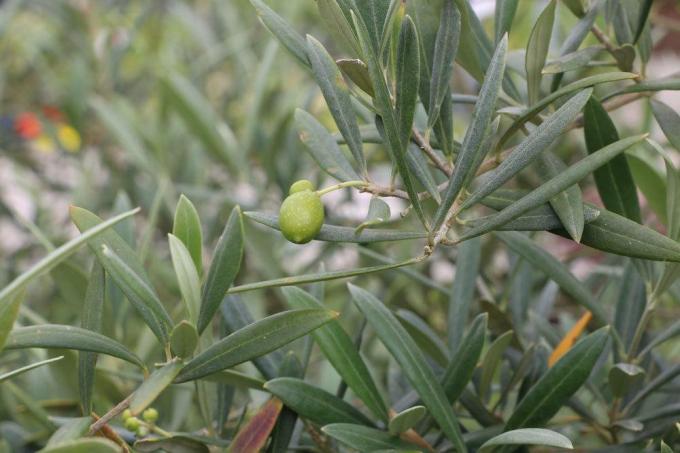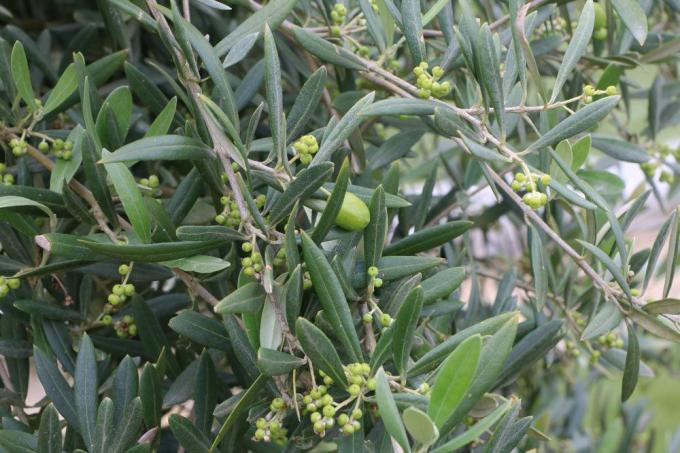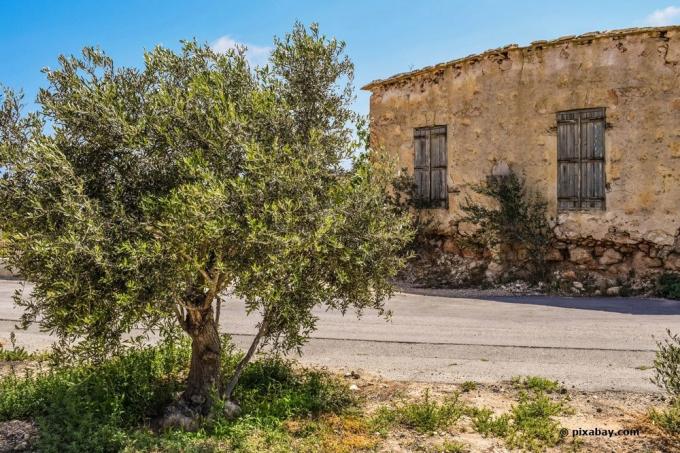
table of contents
- care
- Location
- Soil / substrate
- plants
- to water
- Fertilize
- Cut
- Overwinter
- Multiply
- Diseases
Profile and care information open +conclude -
- Flower color
- White
- Location
- Sunny, full sun
- Heyday
- April May June
- Growth habit
- upright, spreading, bushy, perennial
- height
- up to 15 meters high
- Soil type
- stony, sandy, loamy, gravelly
- Soil moisture
- very dry, moderately dry
- PH value
- neutral, weakly alkaline, weakly acidic
- Limescale tolerance
- Calcium tolerant
- humus
- rich in humus
- Poisonous
- no
- Plant families
- Olive family, Oleaceae
- Plant species
- Potted plants, Mediterranean plants, Houseplants
- Garden style
- Terrace garden, winter garden, Italian garden
Of the Olive tree, botanically called Olea europaea, is one of the oldest cultivated plants. The wood, which in old age forms a characteristically gnarled and primeval looking trunk, has its origin in the countries around the Mediterranean. We can also grow olive trees and even bear fruit. The prerequisite for this, however, is that some basic rules are observed. Because of the limited winter hardiness of the tree (Olea europaea), proper wintering is essential.
care
While the care of an olive tree in the Mediterranean area is very easy, it is a bit more complex in Central Europe. However, if one takes into account its origin from warmer climatic conditions, cultivation is not really complicated.
Location
The olive tree (Olea europaea) is an evergreen tree that is only partially hardy in our areas. When it is cultivated north of the Alps, its location is therefore largely dependent on the temperatures in winter. From temperatures of -5 degrees, frost damage must be expected. Therefore it can only be planted outdoors in regions with mild winter. Basically, the wood should be as warm and sunny as possible.

- Light requirement: as full sun as possible
- After getting used to it, it can also tolerate the midday sun
- as warm as possible
- protected from cold and heavy rain
Olea europaea tolerates great heat without any problems. The tree also tolerates drought well. What the plant doesn't like is high humidity and waterlogging. In these cases, the olive tree becomes susceptible to fungal diseases or root rot.
Soil / substrate
With regard to the nature of the soil, the wood is relatively undemanding. The earth just can't be too wet. In its homeland, the olive tree, Olea europaea, grows on calcareous, rather stony soils. The substrate should therefore be well permeable for water both in the garden and in the planter.
- sandy-loamy
- rather low in nutrients
- Also thrives on poor soils
- well permeable to water and air
- profound
- pH value: 6 to 8
- calcareous
plants
Since the year-round outdoor cultivation of the olive tree is only possible with us in wine-growing areas, it is usually cultivated as a pot or container plant. The Rhineland, the Lower Rhine and the wine-growing regions in southwest Germany (Moselle, Baden-Württemberg, Palatinate) are considered to be particularly mild. Only plant particularly hardy, robust varieties outdoors, making sure that they are in a protected location and that the soil conditions are optimal.

- Planting time: spring
- Plant spacing outdoors: 3 to 7 m depending on the variety
- ensure good floor drainage
- Planting hole: twice the ball width and depth
- Water the pads well before planting
- fill up with permeable substrate
- start easily
Bucket culture
We usually cultivate olive trees in planters. When planting, only use suitable substrates and a pot with holes in the bottom from which excess water can drain. Otherwise, similar conditions apply as for outdoor plants. Note that the tree has quite deep roots and older trees need a bucket with a diameter of at least 60 cm.
- create a thick drainage layer (gravel, lava granulate, expanded clay)
- Substrate: soil for citrus plants or Mediterranean plants
- loamy-sandy garden soil
- likes somewhat cramped roots
- Do not choose a pot that is too large
Alternatively, you can use a self-made substrate. It should consist of two thirds to one half of conventional potting soil and one third to 50% sand. Good results can also be achieved with the addition of 10% coconut fibers or fine lava granules.
to water
The leathery, thick-fleshed leaves are one of the olive tree's most important survival strategies. Their special structure helps the wood to save water. Well-grown plants should only be watered sparingly. The main thing is to avoid waterlogging. Older, well-ingrown olives are only poured again when the root ball has dried out well. Young plants and potted plants are kept a little more humid during the summer months, but never wet. In winter, potted plants should only be watered very sparingly because of the reduced metabolism.
Fertilize
The olive tree, Olea europaea, has adapted very well to the conditions in the Mediterranean climate. This also means that it often grows there on very poor soil. For this reason, no additional nutrients are required when trees are planted out. However, you should fertilize olive trees in pots at least once a month with a special fertilizer for Mediterranean plants over the irrigation water or use a long-term fertilizer.

Repot
While young plants should be checked annually to see whether a larger pot is necessary, repotting every two to three years is sufficient for older olive trees. Typically, repotting takes place towards the end of winter, i.e. before the start of the new growing season. The new plant pot doesn't have to be much bigger than the old one. As a rule, vessels one or two centimeters in diameter are sufficient. If a larger planter is no longer possible, it is advisable to cut off about one to two centimeters from the outer and lower root ball and fill it with fresh substrate.
- Do not repot until there is no more space in the pot
- Time: late February to March
- Use only a slightly larger plant pot
- Carefully loosen the root network
- cut the root tips of old trees
- Top up with fresh substrate
- water only lightly
Cut
When cutting an olive tree, the motto is: less is more. If anything, the wood should only be cut very moderately. Olea europaea grows very slowly, so there is no danger that the wood will grow wild or overgrown without pruning.
Upbringing
The purpose of the upbringing is to bring the crown into shape. The external shape is corrected by shortening shoots that are too long. This is preferably done behind a leaf base or eye. The following applies to the cut: the more lush the branches have grown, the more that can be cut off. However, more than about 10 to 20% should not be reduced. If the crown is still very weak and sparse, you should be restrained when cutting.

Conservation cut
In contrast to the upbringing pruning, the conservation pruning is not about a particularly attractive or favorable shape of the tree. Only those shoots and branches are cut that weaken the wood. These include as follows.
- dead branches
- sick instincts
- all the shoots that grow inward
- one of two intersecting branches
Overwinter
In the summer months, an olive tree is very easy to care for. This is due to the fact that in a good location it finds conditions that largely correspond to those of its Mediterranean home. However, since our climate is significantly cooler in winter than the tree is used to, there are a few basic things to consider. This is the only way to bring the plant through the cold season without damage. Under favorable conditions, an olive tree can overwinter outside. If these cannot be met, it is safer to move it to winter quarters. In general, the tree is considered to be hardy up to -10 degrees, but this value depends on various factors, including, for example, the age, the location and the variety.
Winter mild regions
Mediterranean plants such as Olea europaea can only hibernate in areas where the winters are very mild. It is advisable to look for a robust variety when buying it. Olea europaea 'Lessini' is one of the most winter-resistant varieties. However, some protection should always be planned.
- protected location
- on a house wall or a wall
- under a roof (protects against moisture)
- Wrap the trunk by the end of December at the latest
- Cover the floor with fleece (protection from moisture)
- the fleece must be resistant to frost and moisture
- for example a double layer of thermal fleece

Experience shows that the months of January and February in particular harbor the highest risks for severe frosts. From March onwards, the prolonged frosts are usually over and the tree can be unpacked again. Nevertheless, there is still a risk of cold snaps even now. So it is important to stay alert.
Cold regions
Since the risk of frosts is very high in most areas of Central Europe, it would be too risky to leave the valuable olive tree outdoors in winter. The best way to do this is to plant in a container.
- Place in a rain-protected place from September
- Bring them to their winter quarters after the first light frosts
- Temperatures for wintering: 5 to 10 degrees
- Lighting conditions: as bright as possible
- possibly use plant light
- unheated winter garden
- Glasshouse
- bright staircase
- unheated adjoining rooms
There is no fertilization during the winter rest, only very sparingly poured. From around the end of March, when the temperatures rise permanently above 5 degrees again, the container plant can slowly get used to the outdoor conditions again. For the first two weeks, however, it should still be protected and placed in partial shade.
Multiply
Olea europaea can be easily propagated by cuttings. Cultivation from seeds is much more tedious.
Cuttings
The propagation of an olive tree from cuttings promises quick success and is easy to do even by laypeople. Trees pulled from cuttings not only grow faster than sown plants, they are also several years more likely to bear fruit. While a seedling takes around 10 years to fruit, a tree pulled from cuttings takes an average of six to seven years.
- Time: spring or early summer
- for example when cutting the plant
- Cut the shoot tip about 10 to 15 cm long
- remove lower leaves
- Leave a maximum of 3 to 4 leaves
- put in a glass with water
- Change the water daily
- alternatively put in moist cactus or potting soil
- Planting depth about 3 cm
- set up brightly, but without direct sunlight
- warm and protected
Depending on the temperature and light conditions, it can take several weeks to months for the cutting to form roots.

Seeds
Since the olives that we buy are usually pretreated or pickled, it is not possible to grow new plants from the seeds. However, seeds can be bought from specialist retailers. Of course, you can also harvest fully ripe fruits on a holiday in the Mediterranean Sea and remove the seeds from them.
- Remove the pulp
- Clean the core under running water
- Planting depth: about 1 cm
- Substrate: moist sowing soil, cactus soil
- cover with foil or gas
- Location: warm and bright (no direct sun)
- keep evenly moist
In the best-case scenario, germination takes about four weeks. However, the process usually takes up to four months. As soon as the germination process has started, a lot of light is necessary, otherwise the seedling will cure. Long, thin shoots do not create good conditions for strong and healthy growth. At moderate outside temperatures above 10 degrees, the young plant can also be placed in a sheltered place on the balcony or terrace. Don't forget to bring the tree back inside when the temperature drops. After the second pair of leaves has formed, the seedling is repotted in a 10 cm large pot in permeable substrate. In the first few years, the young plants should be cultivated in the tub and overwintered frost-free.
Diseases
Diseases and Pests
If the olive tree (Olea europaea) is in an ideal location and receives a minimum of care, the plant is very robust and rarely gets sick. As a rule, spider mite infestation occurs almost exclusively in the case of severely weakened plants in unsuitable winter quarters. Mealybugs or other sucking pests. Too high temperatures or insufficient humidity make the plant susceptible. If you check the olive tree regularly in winter, a slight infestation can already be brought under control with home remedies. In any case, it is necessary to ensure better winter conditions.
Care errors
Often, care errors are to blame when the wood is ailing. Check both the site conditions and the moisture in the root ball when the olive tree gets yellow leaves.

Leaf loss
The olive tree is one of the evergreen trees that keep their leaves all year round. Its leaves rejuvenate over a long period of time. On average, they stay on the plant for about three years. It is therefore quite normal that individual leaves dry up and fall off again and again and do not need to be worried. If the tree suddenly loses masses of leaves or if the foliage turns yellow - no matter what time of year - something is wrong. Causes of leaf loss can be:
1. Waterlogging
It is important that the cause of the leaf fall is found out and eliminated quickly, otherwise a total failure can occur in a short time. The olive needs very little water during hibernation, so it can only be watered in sips every few weeks without any problems. If the olive tree has become too wet, this can be determined by a wet, possibly foul-smelling root ball. In this case it must be repotted immediately.
- remove as much wet soil as possible
- shower off any residues with the shower head
- cut out any rotten and dead roots
- Rinse the pot with hot water
- Put in fresh substrate
- do not water and fertilize for the next few days
- Place in partial shade for at least 2 weeks
2. Temperatures too cold
Both in autumn and in spring it can happen that suddenly frosts occur and the plant is in an unprotected place in the tub on the terrace or balcony. In order to avoid further damage, the tree must be taken to winter quarters if the temperature drops again (briefly). If these are no longer to be expected, he can stay outside. As a rule, the wood recovers relatively quickly. Frozen shoots should be cut out.
3. Lack of light
The olive tree does not shed its leaves in autumn. Nevertheless, it significantly reduces its metabolism in cool temperatures. A warm winter in the room should be avoided if possible. At temperatures above 10 degrees, the tree does not go into hibernation. This costs the plant a lot of strength and makes it susceptible to pests and diseases. If you don't have a bright and at the same time cool room to overwinter, you can, for example, in the dark Garage or a basement without a window with a plant light for sufficient lighting care for. Otherwise the olive tree will lose all of its leaves and possibly die.



